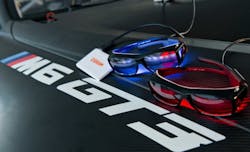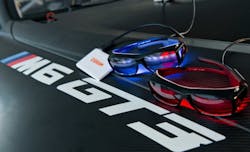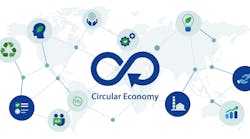Human-centric lighting will speed ahead at a grueling 24-hour race in Germany this week, where drivers will don special Osram eyeglasses.
The human-centric lighting concept will literally race ahead for a day this week when drivers and engineers at the annual 24-hour endurance contest on Germany's Nürburgring track will try to stay alert by wearing special LED-equipped eyeglasses.
Interested in articles & announcements on human-centric lighting & smart lighting applications?
German LED lighting giant Osram is equipping the BMW Motorsport team with eyewear that emits a heavy dose of blue frequencies, which are known as a stimulant. Drivers and engineers in the pit and in the control room will don the glasses both before and during the grueling event, known as the Nürburgring 24 Hours Race.
Specially-tuned Osram LED luminaires in common rooms and the pit area will also emit high doses of blue during the competition, which starts on Saturday, May 27th and finishes on the 28th.
Eyewear that emits blue frequencies will keep drivers alert, while the red version will help them relax during their breaks, Osram said.
“Osram will be supplying activating light for drivers and engineers both before and during the race, enhancing their alertness and boosting their concentration,” Osram said. “LED light glasses are used to help the drivers prepare for races. The blue LED light prepares them for the competition by stimulating the central nervous system. In addition, special luminaires are installed in common rooms and the pit wall control center for the benefit of both drivers and engineers. This range of solutions is designed to mobilize the energy of drivers and engineers exactly when needed during the arduous 24-hour race and help them sharpen their focus.”
Learn more about human-centric lighting and how light promotes health and productivity at the 2017 Lighting for Health and Wellbeing conference July 27 in Newport Beach, CA:lightingforhealthandwellbeing.com
The Nürburgring 24 is a race of touring cars, which are normal cars souped up for extra speed and endurance but which are not as fast Formula One cars. In the past, about 200 cars have entered, each with up to four drivers taking turns limited to 150 minutes per stint around the track's north loop, called the Nordschleife.
Osram indicated that glasses emitting red light will help drivers relax during breaks.
“The competition at the Nürburgring 24 Hours is possibly more intense this year than ever before in the history of this iconic race. That makes the details all the more important,” said BMW Motorsport Director Jens Marquardt. “As such, I am really happy that we have Osram on board as Official Partner. With its innovative solutions and experience in the field of light, the company will make a valuable contribution to allowing our drivers to adapt to the unique challenges of the Nordschleife at night during the race.”
Human-centric lighting (HCL), also known as circadian lighting or biological lighting, tunes LED frequencies to color temperatures and brightness that suit certain tasks. It works on the general circadian principle that humans, conditioned by millions of years under the sun, have biologically evolved so that the blue light of morning stimulates and the ambers of evening relax.
Because LEDs are digital and tunable, they can potentially deliver the right light for the right setting in offices, hospitals, schools, homes and other environments. Many lighting companies are now pursuing HCL opportunities. Just this week, for example, Finnish lighting company Helvar introduced software to help control circadian lighting scenes. Danish circadian lighting specialist Chromaviso has outfitted many hospitals with different lighting schemes, which in some instances have reduced the need to administer drugs (see note below).
Osram itself has used its special eyewear with a German ski team and has installed circadian lighting at the St. Augustinus Memory Center in Germany to help dementia patients rest better, among other examples.
NOTE: Watch for LEDs Magazine's upcoming feature story in the May/June issue revealing how human-centric lighting from Chromaviso is improving the results of endoscopic surgery.
MARK HALPERis a contributing editor for LEDs Magazine, and an energy, technology, and business journalist ([email protected]).







